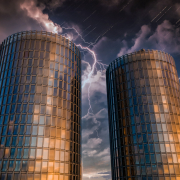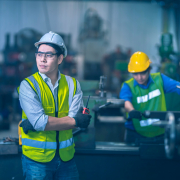How to Prepare Your Business for a Natural Disaster or Emergency
If the COVID-19 pandemic taught us anything, it reminded us that our businesses MUST be prepared for any natural disaster or emergency. Without a good disaster response plan, you may find yourself scrambling to keep your business afloat and keep employees and customers safe and happy.
In this blog, we discuss the 5 basic steps of emergency preparedness in business:
- Built a disaster preparedness team.
- Assess your unique risks.
- Create your emergency response plan.
- Prepare your lines of communication.
- Test & review disaster protocols.
Build a Disaster Preparedness Team
First, assemble a disaster response team. Decide who within your company should be involved in the emergency planning process.
The kind of work your team tackles will fall into the following four categories:
- Risk assessment
- Planning & implementation
- Communications
- Training & review
Assess Your Unique Risks
First, consider the different types of natural disasters and emergencies your business might face. Emergencies to think about include – but are not limited to…
- Fires and explosions
- Floods and hurricanes
- Earthquakes, tornados, and mudslides
- Icy conditions or snowstorms
- Wildfires
- Severe weather situations
- Natural disasters
- Infectious event response and risk mitigation
- Lighting strikes and power surges
- Utility failure
- Biohazards
- Acts of terrorism or civic unrest
- Cyberattacks or phishing
Depending on the location and nature of your business, certain disasters will be more likely.
For example, if your facility is in a warm coastal area, you can expect a risk of hurricanes and flooding. However, you’ll unlikely face any snowstorms or wildfires.
Or say your company relies heavily on computer programs or data for day-to-day operations. Preparing for cyberattacks and phishing attempts is going to be more important to you than it may be for other companies that don’t handle tons of data.
As you evaluate your business’s vulnerability to each kind of emergency, think about the potential hazards and impacts on your facility and business operations.
Consider the following questions:
- How might the event create an unsafe environment for employees and customers?
- Which critical assets (i.e. servers, computer hard drives, filing cabinets, products, machinery, etc.) do you need to protect?
- What sort of lost or delayed sales and income can you expect?
- How long could the disaster disrupt production or service?
- Will there be any extra costs to maintain business operations during the disaster recovery period?
- How might the emergency cause customer dissatisfaction?
- Will the event create any delays to business development plans?
Create Your Emergency Response Plan
Once you have a good idea of the disaster risks your business faces, you can start working up official emergency response plans for each risk.
- Think about the steps that need to be taken to ensure the immediate safety of personnel and customers.
- Devise a Business Continuity Plan to ensure your business is able to resume operation quickly in the event of an emergency or disaster.
- Install a dependable security and alert system.
- Make sure you have essential emergency resources – i.e. backup equipment and systems, basic emergency supplies, and alternative sources of power, light, and communication.
- Schedule routine drills and training exercises with company employees.
- Back up important data and programs.
- Protect critical business records in a safe that is resistant to fire, heat, and burglary.
- Secure equipment and furniture – i.e. machinery, cabinets, and computers.
- Determine how you will educate staff about emergency plans and personal protection techniques.
- Decide on a chain of command for plan implementation.
- Create policies for employees who are directly impacted by a disaster.
- Establish other critical policies – pertaining to absences, pay, and more!
Once you have created your emergency plans, send them to all the appropriate company personnel. And post it somewhere physically and/or online where they can easily access it for later reference.
Prepare Your Lines of Communication
Your plans are in place! Now you need to solidify your communication plans.
Keep current phone numbers for your suppliers, utility companies, local media, emergency personnel (i.e. fire, hospital, ambulance, and police), and disaster relief agencies on hand.
If an emergency arises, which key decision-makers within your organization will you call first?
In the immediate aftermath of a disaster, clear communication will keep personnel and customers safe. Then, effective company-wide cooperation will help keep your business running as smoothly as possible.
To avoid major hiccups, discuss emergency plans with all the appropriate people BEFORE disaster strikes.
If you work with clients, patients, or other stakeholders, you’ll need a roadmap for contacting them in the event of an emergency. Transparent communication amid a crisis displays professionalism and reliability.
Test & Review Disaster Protocols
To keep your emergency protocols up-to-date and reliable, conduct regular testing of your disaster response plan.
That means…
- Holding routine practice drills
- Requiring personnel to undergo emergency training exercises and workshops
- Maintaining emergency supplies and equipment
- Evaluating your plan from time to time for potential improvement
- And incorporating new knowledge and modern technology
KFM 24/7 | Disaster Preparedness & Response
With proper planning and review, your business will be ready to respond calmly in the face of a natural disaster or emergency. However, ironing out all the details of your disaster response plan can be a daunting task.
That’s where WE come in!
KFM 24/7 has the experience and expertise to guide you through a commercial natural disaster and emergency planning process. We can do things like…
- Determine the disasters and emergencies most likely to impact your business.
- Provide a thorough assessment of your facility and available emergency resources.
- Help you develop a disaster response plan.
- Offer rapid response to minimize damage to your facility.
- And more!
Learn more about our disaster preparedness and response services.
Read More:


